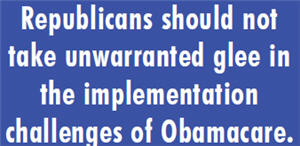The Disastrous Launch Of Obamacare
By John McManus, The McManus Group, jmcmanus@mcmanusgrp.com
 President Obama’s most ardent supporters now concede that the rollout of Obamacare has been disastrous. Washington Post commentator and Obamacare booster Ezra Klein stated that the launch of Obamacare “is not glitchy, not troubled, but a failure.” He concluded that “The Obama administration’s top job isn’t beating the Republicans. It is running the government well. On this — the most important initiative they’ve launched — they’ve run the government badly.”
President Obama’s most ardent supporters now concede that the rollout of Obamacare has been disastrous. Washington Post commentator and Obamacare booster Ezra Klein stated that the launch of Obamacare “is not glitchy, not troubled, but a failure.” He concluded that “The Obama administration’s top job isn’t beating the Republicans. It is running the government well. On this — the most important initiative they’ve launched — they’ve run the government badly.”
Liberal comedian John Stewart grilled HHS Secretary Kathleen Sebelius and commented that it would take less time “to download every movie ever made than sign up for Obamacare.” Indeed, two weeks into its launch, the healthcare consultancy Advisory Board found that just 5,000 people enrolled in Obamacare across the 36 states that rely on the troubled HealthCare.gov federal exchange website. The administration has refused to release its own data — it likely does not even want to know.
Only a trickle of the 15 million individuals who visited the website in the first couple of weeks were able to actually enroll in a plan. Some individuals were able to register but never able to log in even after numerous attempts over a period of weeks. Others received a message to try later or just faced a blank screen. As a result, the number of visitors to the federal government’s HealthCare.gov website plummeted 88 percent between Oct. 1 and Oct. 13, according to a new analysis of America’s online use.
Just as troubling, for the few who have been able to enroll, plan premium and coverage information has been unreliable. Insurance companies report that some enrollment files were sent to the wrong insurer, and others have received inadequate income information from the government to determine the enrollee’s subsidy and premium. Clearly, knowing whether individuals are enrolled in your plan and calculating their premium are rather fundamental components of making the program work.
We Should Have Expected These Problems
Most frustrating of all, this still unfolding disaster was predictable. As I reported in my column a couple months ago, a June Government Accountability Office oversight report found that CMS was behind schedule in activities “that cross the core functional areas” in nearly every aspect of the exchange and was unlikely to be prepared by Oct. 1.
The administration repeatedly analogized the ACA (Affordable Care Act) implementation debacle to the initial glitches in the Medicare Part D drug benefit in 2006 that could be easily addressed and overcome. Jay Carney, spokesman for the White House, said, “There will be glitches in the rollout of this as there have been in every program. A good reference point is Medicare Part D, which caused a huge amount of consternation among consumers when it was initially rolled out.”
But David Brailer, who worked as HHS’ first national coordinator of health information technology during the launch of the Medicare drug benefit in 2006, pointed out that the administration should have anticipated that the federal exchange would trigger a rush of Americans onto the website, either as onlookers or outright buyers. In an interview with the Washington Post he noted the exchange was built to accommodate 50,000 to 60,000 visitors at a time — fewer than half as many as the enrollment site for Medicare drug benefit could handle, and at a time when use of the Internet is more ubiquitous.
When Medicare Part D was being designed, establishing a working software architecture was a priority, and the enrollment portal was online and being tested weeks in advance. The CMS plan finder worked for the vast majority of the millions of Medicare beneficiaries who selected a drug plan of their choice, enrolled, and now receive drug coverage with little incident.
Carney’s analogy is unfounded and only furthers the administration’s dismissive approach to addressing the fundamental shortcomings of the ACA statute and its implementation.
Finding Common Ground Could Have Helped
A sensible solution that could have gained bipartisan traction would have been to delay the rollout of the Obamacare exchanges for one year. But this would have required the Obama administration to acknowledge that it was unprepared to actually implement the law.
Of course, most Republicans had little incentive to assist with the rollout of a product they abhorred and campaigned against. But bipartisan consensus could have been forged to delay implementation of the exchanges and its subsidies because that would produce savings in the 10-year budget window, which could be devoted to other priorities, such as repealing the fatally flawed physician payment formula, minimizing certain incorrigible ACA provisions, or reducing the deficit as part of a debt-ceiling compromise (a proposal later proffered in the House of Representatives’ second attempt to raise the debt ceiling). And more strident Republicans could have viewed a delay of Obamacare as an installment toward repeal.
 But finding common ground between the parties on a controversial area like healthcare — and Obamacare in particular — actually requires dialogue between key policy makers. A conceivable conversation between key Republican and Democrat policy makers could sound like this: “You get a more orderly rollout of your signature achievement; we get a policy win on repealing an offensive aspect of that bill for which there is consensus — e.g. the medical device tax or the Independent Payment Advisory Board.”
But finding common ground between the parties on a controversial area like healthcare — and Obamacare in particular — actually requires dialogue between key policy makers. A conceivable conversation between key Republican and Democrat policy makers could sound like this: “You get a more orderly rollout of your signature achievement; we get a policy win on repealing an offensive aspect of that bill for which there is consensus — e.g. the medical device tax or the Independent Payment Advisory Board.”
Real, substantive discussions between policy makers of the two major parties should be initiated by the executive office — people running the country.
For the administration to commence an uncomfortable and potentially embarrassing conversation of this nature, it must first examine the hard facts in a sober and analytical fashion. This requires the shelving of rote talking points designed to further political advantage and, instead, properly diagnosing a problem and starting to seek solutions.
Likewise, the Republican fixation on repealing Obamacare in the face of intractable odds has also deterred effective oversight of the program and a bipartisan dialogue on how to reform it. Instead of holding congressional hearings and focusing the public’s attention on the unfolding implementation debacle of Obamacare, Republicans chose to tie Obamacare defunding to funding the rest of government operations precisely on the day that enrollment commenced — Oct. 1. It was a remarkably poor decision and terrible timing.
For all who can perform basic second-grade math, it was clear that Republicans needed not just 218 votes in the House and 51 votes in the Senate to defund Obamacare, but 290 votes in the House and 66 votes in the Senate. This two-thirds super-majority vote is what the Constitution requires to overcome a presidential veto. Even the most ardent opponents of Obamacare should acknowledge that President Obama was not going to sign a law repealing his signature achievement in which his name is now embedded. Senator Cruz’s approach to defunding Obamacare was fundamentally flawed from its inception because there was no endgame.
Republicans should not take unwarranted glee in the implementation challenges of Obamacare, as it indicates a very strong public interest in signing up for the new coverage, and the open enrollment will last for six months. But they should refocus on proper oversight of the program and be open to reforming the program, which will certainly have huge implications on their constituents and the fiscal health of the country.
However, President Obama is the sole leader of the country. Flatly stating he will not negotiate, and refusing to acknowledge or comprehend the true disaster that is unfolding on his signature achievement, are no way to run the country.
